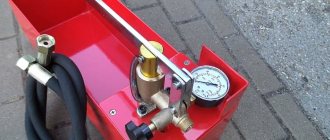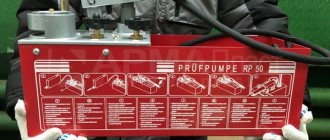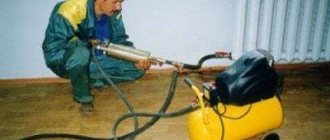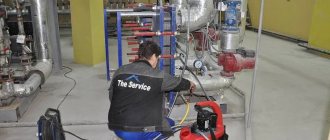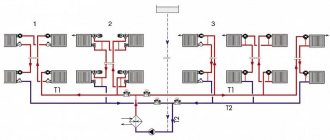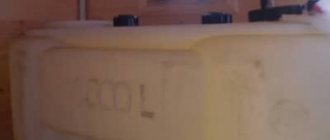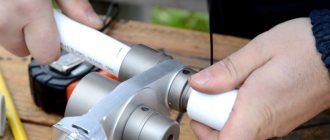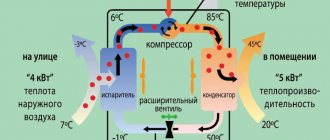For a heating system to be reliable and energy efficient, it is not enough to perform high-quality design and installation. It is important to carry out commissioning work promptly and correctly, which includes pressure testing the heating system and flushing it. The mandatory technical control procedure is carried out upon completion of the installation of a new heating system, at the beginning of the heating season and after repair work. In apartment buildings, such work is carried out by competent organizations. In a private house, you can check the performance of the heating system yourself. This will require special equipment and knowledge of the requirements of regulations regulating the maximum pressure for the system and the time interval for checking different heating networks.
Features of testing
Pressure testing is a check of the heating system under pressure at the final stage of work.
Pressure testing of heating pipes is the final stage after installing a new or repairing an existing system before signing a certificate of work performed.
The procedure involves testing by pumping air or liquid into pipes under standard pressure, which exceeds the working pressure several times. For a private house, the check is carried out in this way:
- heated floor contours;
- heating radiators;
- collectors;
- locking fittings;
- points for connecting pipes to equipment;
- circulation pumps;
- boilers;
- boilers.
This test clearly demonstrates the quality of the material used and shows whether the selected equipment and pipes can withstand high pressure while maintaining tightness at the connection points. If the test result is positive, the heating can be started in normal mode without fear of emergency situations.
According to the rules, pressure testing of the heating system is carried out in positive outdoor temperatures. The air temperature in the room should not be lower than 5 degrees. At subzero temperatures, pressure testing is carried out only in emergency cases.
Requirements SNiP 41-01-2003
The pressure in the system, which is 2 times higher than the norm, lasts for 2 - 3 hours.
The requirements of this regulatory document state that hydraulic tests indoors must take place under conditions of positive air temperature. Water systems must withstand pressure of at least 0.6 MPa without collapsing or losing integrity.
During testing activities, the pressure must not exceed the limit value established for the pipeline, fittings and heating devices.
When performing hydraulic pressure testing, water is injected into the pipeline and, using special equipment, a hydraulic pressure is created that exceeds the standard value by 1.5-2 times. The system is left in this state for the required time, during which observation is performed to detect leaks. When checking plastic pipes, the operating pressure is first maintained for 2 hours, and in the third hour the pressure is increased by 30%.
The maximum pressure when carrying out hydraulic pressure testing of the heating system and radiators is 10 bar, provided that the elements being tested were initially designed for this pressure.
Requirements SNiP 3.05.01–85
The requirements of this regulatory document indicate that pressure testing of the thermal unit of a water heating system is carried out using the hydraulic method, increasing the pressure by 1.5 times the operating value. Within 5 minutes, the area being tested must withstand this pressure without compromising its integrity or causing leaks - this means that it has passed the test and is ready for normal operation.
About personnel and equipment
A heating pressure test pump is a classic example of additional equipment. It is connected to the main circuit to control the increased pressure inside the pipes.
Pumps with manual drives or powered by electricity are also used. For most household tasks, hand tools are sufficient.
Hand pumps develop a force of 25-50 bar. This is enough to check the tightness of a small five-story building.
Installation for hydraulic tests PROMMASH TEST
There are other advantages that distinguish manual installations.
- Due to the small dimensions of the equipment, it can be effectively used within small spaces. A very convenient option not only for personal use, but also for professional activities.
- Affordable price for equipment. Hand presses have always been famous for their affordable price tags.
- Operating parameters with a range that meets the heating needs of medium and small class. A regular pump is enough to generate pressure that is two or more times higher than normal operating levels.
- A simple design, known for its high reliability and long service life. The pump has a simple design, in which there is simply nothing to break.
Electric pumps are used to carry out hydraulic tests for large circuits with many branches.
Such mechanisms allow you to maintain pressure that cannot be achieved when working with other manual units. This equipment necessarily contains self-priming pumps capable of pumping up high pressure.
Electrical installations have ample opportunities for connection to the heating pipeline. Either through a drain valve through a hose, or for this they use a tap through which the pipe is filled with liquid. The connector for the Mayevsky tap can also be used in such connections.
Electric cars have special control units. They have additional protection in case of overheating. Users set their own operating temperature limits.
If the temperature rises above this level, then excess pressure is released, after which the installation is not put into operation for some time until the required parameters return to normal.
Conditions for performing crimping work
Pressure testing of the heating was carried out correctly and in full if all conditions were met during its implementation:
- During testing, no other work is allowed at the site.
- If pressure testing of the heating system and radiators is carried out by a specialist company, it must proceed in accordance with the plan agreed by the lead engineer. The instructions must contain information about the work to be done, their sequence and the equipment used.
- The presence of persons other than specialists conducting tests at the facility, turning it on and off is not allowed.
- If any work is being carried out at adjacent facilities simultaneously with testing, it is important to ensure the safety of its implementation.
A visual assessment of the operation of heating devices during their inspection should be carried out only under operating pressure conditions. Upon completion of the work, a report is drawn up confirming the tightness of the heating system.
Types of tests and timing
Pressure testing of the heated floor is carried out before pouring the concrete.
Leak testing of the heating unit is carried out in the following situations:
- In a private house, an initial check of the system is carried out at the stage of preparing the house for commissioning. Diagnostics of the pipeline in the grooves and the contours of the heated floor is carried out before sealing and pouring the screed. When the mortar has completely dried, it is recommended to conduct additional hydraulic tests to identify and eliminate possible leaks before laying expensive finishing material.
- To prepare the heating supply network for unplanned switching on, a periodic hydraulic test is carried out once a year after the end of the heating season. The check is also carried out immediately before the start of the heating season at positive ambient temperatures.
- One-time extraordinary checks of the strength and tightness of the system follow immediately after the completion of scheduled and unscheduled repair activities.
All of the above measures are diagnostic in nature and allow timely identification of problems with the heating system, leading to its shutdown and repair.
Household heat meters
establishes the obligation to equip apartment buildings with common house meters for water, electricity, heat and gas. They are usually installed in technical rooms (basements, utility rooms).
Using counters, you can record the amount of resources spent. At the same time, not only individual meters are installed for thermal energy, but also multi-tariff ones, which allows you to pay cheaper at night rates.
The management company is responsible for the maintenance of common house appliances. It monitors that utility bills correspond to the amount of resources consumed.
Find out how to install a communal heat meter in an apartment building.
Crimping process
The pressure for pressure testing is selected based on the technical characteristics of the materials, radiators and the state of the system in the house
. The pressure used in the heating system is selected depending on its purpose and type of equipment. For crimping input nodes, a pressure of 16 atm is used, for the heating system of a multi-storey building - 10 atm, for a private house - 2-6 atm.
When performing pressure testing, the wear and tear of the building and heating system should be taken into account. In new buildings, the test is carried out with a pressure exceeding 1.5 - 2 times, and in dilapidated houses no more than 1.5. If the heating radiators are made of cast iron, during the test the pressure cannot exceed the limit of 6 atm. For convectors this value is 10 atm.
The decisive criterion when choosing pressure during system testing is the parameters reflected in the technical data sheet of the equipment. The “weakest” part of the system is taken as the starting point.
Sequence of work
Crimping occurs according to a single algorithm, which looks like this:
- If work is carried out in a private house with autonomous heating, the boiler is turned off. Turn off the section of the heating system to be checked.
- Drain the water.
- The pipeline is filled with water whose temperature does not exceed 45 degrees. While filling is taking place, air is removed from the system.
- Special equipment is connected to the system - a heating pressure tester, with which the pressure is pumped up to the operating level. At the same time, a visual inspection of the area being inspected is carried out.
- Carry out a gradual increase in pressure to the value specified in the test plan. Perform a visual inspection of the system for leaks and damage.
- The resulting value is recorded for 10 minutes using a pressure gauge. The readings are recorded. If it remains unchanged, then the system is sealed and ready for use.
The pneumatic testing method is used if the hydraulic method cannot be used. For example, at sub-zero temperatures. The reference point for identifying a leak in a pipeline is the readings of the pressure gauge. Places of possible leakage are determined by treating them with a soap solution.
Checking the water level and pressure in the heating system
As a rule, the system includes a pressure gauge - it is required to check the heating system. The pressure should be between one and one and a half atmospheres. Such indicators mean that everything is fine inside and there is no need to add water. Accordingly, lower indicators mean that there is not enough water and it is necessary to add it to the communication.
If the boiler is currently heated, then under no circumstances should you add cold liquid - this will cause small cracks to appear in the boiler. Over time this will cause many problems. It is better to add warm water.
If the pressure is low and the water level is too low, then such diagnostics of the heating system indicates a leak. Naturally, in the event that you did not drain the water. All leaks must be immediately identified and repaired. Typically, leaks are found in connecting elements. If the leak is almost invisible, then this is within normal limits.
Heating contractor DESIGN PRESTIGE LLC
Permissible test pressure
A situation where the quality criteria declared by the manufacturer do not correspond to reality.
According to regulatory documents, the pressure during leak testing of heating equipment should be:
- for hot water supply and heating systems with a water heater - 10 atm;
- with convector heating – 10 atm;
- for cast iron and steel radiators – 6 atm.
The following indicates that the equipment has successfully passed the tests:
- During the tests, no fogging of heating equipment was detected - boilers, pipes, radiators, shut-off valves and seams;
- in 5 minutes the pressure inside the circuit decreased by no more than 0.2 bar;
- in 10 minutes in a hot water supply system consisting of metal pipes, the pressure drop did not exceed 0.5 bar;
- if the pipes are plastic, the normal indicator is a pressure drop to 0.6 bar during the first 30 minutes, and to 0.2 bar over the next 2 hours;
- When carrying out air tests of steam heating, the pressure in the first 5 minutes should drop by no more than 0.1 bar.
When testing a DHW system, 5 atm can be added to the operating pressure. When choosing a pressure that exceeds the operating value, take into account the data in the equipment passport.
Chemical flushing of the system
Washing this way is quite simple. Instead of coolant, a special solution consisting of acid and alkali is pumped into the system. After which you need to ensure circulation of the solution for 2.5–3 hours. If this is not a natural circulation line, an air pump can provide it. After this, the liquid is drained and the system is filled back with coolant.
It is strictly prohibited to pour such reagents down the drain, so before purchasing a chemical mixture you must purchase a neutralizer.
The method can be used in two cases:
- When you need to flush a natural circulation system whose pipes are made of steel.
- When you need to restore an old heating system. Since during operation the pipes can become so clogged that the pneumatic pump cannot cope with the task. And if you use a pump with more power, there is no guarantee that the pipes will withstand such pressure.
It happens that the pipes are very old, have traces of corrosion, defects and dents. In this case, washing will be of no use, since the mixture will dissolve the rust and the pipes may begin to leak. The only solution to this problem is to completely replace the pipes.
Types of pumps for testing
Test activities are carried out using manual or electric pumps to build up pressure.
Manual models are equipped with pressure control devices, a tap for shutting off incoming water and a shut-off valve for draining water from a rectangular cuvette. A plunger pump is used to pump water under pressure. The main disadvantage of manual equipment is the low download speed and labor-intensive process.
The best choice would be electrical equipment. Its advantage is the high speed of filling the circuits and automatic shutdown when the required pressure is reached.

